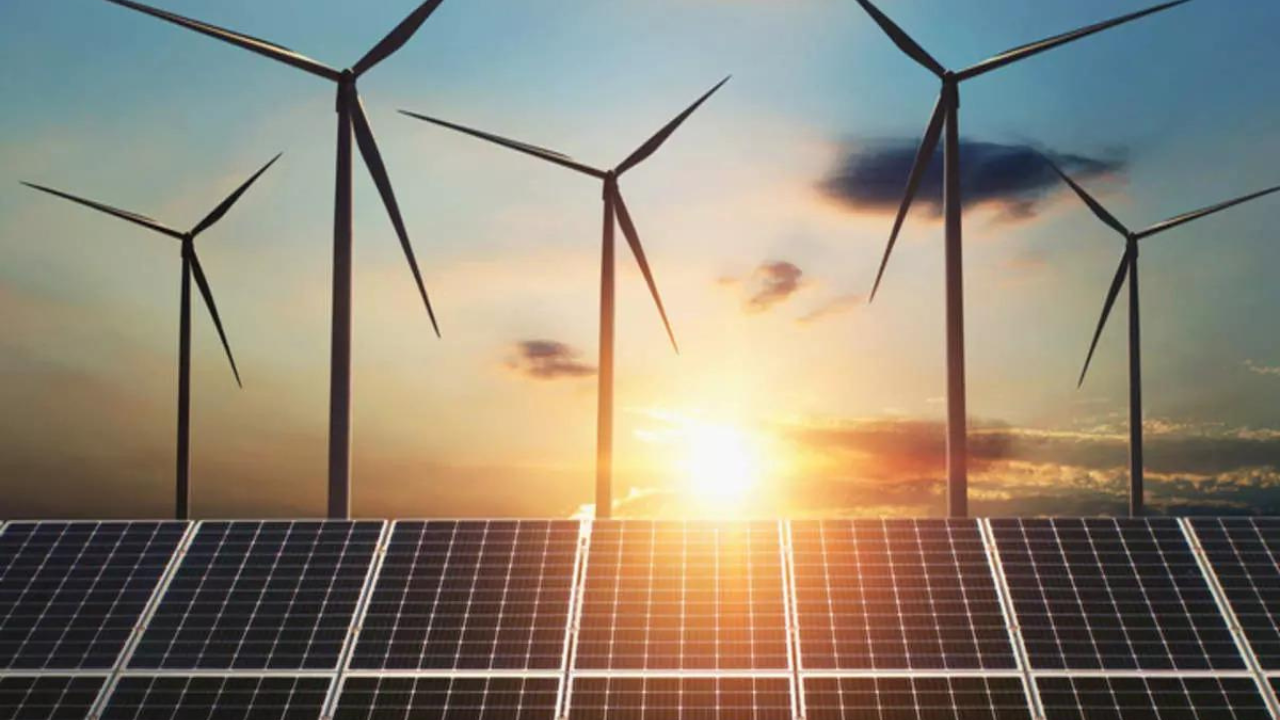India’s power and renewable energy sector attracts large-scale investment. india business news
New Delhi: Very nice Investment 17.05 rupees lakh crore in the pipeline Power And Renewable energy Union Minister RK Singh on Monday said the sector, which has attracted investments of about Rs 16.93 lakh crore since 2014. Thermal power generation up to 80 GW Capacity About 99 GW of renewable energy is currently under construction which we will have by 2030, Singh told reporters.
Briefing reporters on the new rules called the Electricity (Amendment) Rules 2024, Singh said an investment of Rs 16.93 lakh crore has been made so far in the power and renewable energy sectors.
The minister said that the investment of Rs 16.93 lakh crore includes Rs 11.2 lakh crore in sectors like generation, distribution and transmission while Rs 5.73 lakh crore in the renewable energy sector.
He further said that investments worth Rs 17.05 lakh crore are in the pipeline in power and renewable energy sectors.
The minister said that Rs 7.4 lakh crore and Rs 9.65 lakh crore will be invested in the power sector.
He also said that India’s power generation capacity will increase to over 800 GW from about 428 GW at present. India plans to bid for 50GW of renewable energy projects every year.
Regarding the new rules, the ministry said consumers having load and energy storage systems (ESS) above a specified amount are now allowed to install, operate and maintain dedicated transmission lines without the need for a license.
It said allowing such a facility would lead to the emergence of a new category of bulk consumers in the country who would benefit from more affordable power and enhanced grid reliability.
This facility was already available to generating companies and captive generating stations.
The new rules have been set for ease of doing business by industries such as green hydrogen manufacturers and to facilitate energy security as well as energy transition by faster installation of energy storage capacity.
The new rules facilitate bulk consumers and energy storage systems (not less than 25 MW) to connect to the grid easily and at faster speeds.
They will not be required to obtain a license to establish, operate or maintain a dedicated transmission line to connect to the grid.
The new rules also provide that consumers including industry will benefit in getting power at competitive rates by ensuring that open access charges are reasonable.
To rationalize open access charges, new rules have been prescribed along with the methods of determining various open access charges like wheeling charges, state transmission charges and additional surcharges.
The rules inter alia stipulate that for a person availing common network access or open access, the additional surcharge shall be reduced linearly and within four years from the date of providing common network access or open access. Will end.
It also provides that the additional surcharge will be applicable only to open access consumers who are or have been consumers of the concerned distribution licensee.
Thus, a person who has never been a consumer of the distribution licensee will not have to pay additional surcharge.
The rules also improve the financial health of discoms by eliminating the revenue gap and ensuring cost-reflective tariffs.
To ensure financial sustainability of the power sector, it is essential that tariff costs are reflective and all discretionary costs are allowed.
However, it pointed out that regulators in some states have created a huge revenue gap, causing financial distress to distribution companies due to disallowance of various costs, including power purchase costs.
It stated that in order to discourage such practice, there is a need to make statutory provisions to ensure that no such difference exists.
It is also important that any such existing gap in revenues be closed in a time bound manner.
The new rules have been notified to ensure that except in exceptional circumstances like natural calamity, revenue gap does not arise and the gap, if any, is closed in a time bound manner.
The rule states that the tariff will be cost reflective and there will be no difference between the approved annual revenue requirement and the estimated annual revenue from the approved tariff except in natural disaster situations.
It states that such difference, if any, shall not exceed three per cent of the approved annual revenue requirement.
The rule also provides that such difference shall be eliminated in a maximum of three equal annual installments with the carrying cost at the base rate of late payment surcharge specified in the Electricity (Late Payment Surcharge and Related Matters) Rules, 2022. Next financial year.
For the revenue gap existing at the time of promulgation of the rules, it is mandatory that any such gap be included with the carrying cost at the base rate of late payment surcharge specified in electricity, as on the date of notification of these rules. The Delayed Payment Surcharge and Related Matters) Rules, 2022 will be phased out in a maximum of seven number of equal annual installments starting from the next financial year.
Releasing the rules, Singh said the steps taken by the government have reduced the losses of distribution companies from 27 per cent in 2014 to 15.41 per cent in 2022-23.
The minister said that eliminating the requirement of license for dedicated transmission lines for the industry will lead to ease of doing business for the industry, leading to faster industrial growth and more employment generation.
Briefing reporters on the new rules called the Electricity (Amendment) Rules 2024, Singh said an investment of Rs 16.93 lakh crore has been made so far in the power and renewable energy sectors.
The minister said that the investment of Rs 16.93 lakh crore includes Rs 11.2 lakh crore in sectors like generation, distribution and transmission while Rs 5.73 lakh crore in the renewable energy sector.
He further said that investments worth Rs 17.05 lakh crore are in the pipeline in power and renewable energy sectors.
The minister said that Rs 7.4 lakh crore and Rs 9.65 lakh crore will be invested in the power sector.
He also said that India’s power generation capacity will increase to over 800 GW from about 428 GW at present. India plans to bid for 50GW of renewable energy projects every year.
Regarding the new rules, the ministry said consumers having load and energy storage systems (ESS) above a specified amount are now allowed to install, operate and maintain dedicated transmission lines without the need for a license.
It said allowing such a facility would lead to the emergence of a new category of bulk consumers in the country who would benefit from more affordable power and enhanced grid reliability.
This facility was already available to generating companies and captive generating stations.
The new rules have been set for ease of doing business by industries such as green hydrogen manufacturers and to facilitate energy security as well as energy transition by faster installation of energy storage capacity.
The new rules facilitate bulk consumers and energy storage systems (not less than 25 MW) to connect to the grid easily and at faster speeds.
They will not be required to obtain a license to establish, operate or maintain a dedicated transmission line to connect to the grid.
The new rules also provide that consumers including industry will benefit in getting power at competitive rates by ensuring that open access charges are reasonable.
To rationalize open access charges, new rules have been prescribed along with the methods of determining various open access charges like wheeling charges, state transmission charges and additional surcharges.
The rules inter alia stipulate that for a person availing common network access or open access, the additional surcharge shall be reduced linearly and within four years from the date of providing common network access or open access. Will end.
It also provides that the additional surcharge will be applicable only to open access consumers who are or have been consumers of the concerned distribution licensee.
Thus, a person who has never been a consumer of the distribution licensee will not have to pay additional surcharge.
The rules also improve the financial health of discoms by eliminating the revenue gap and ensuring cost-reflective tariffs.
To ensure financial sustainability of the power sector, it is essential that tariff costs are reflective and all discretionary costs are allowed.
However, it pointed out that regulators in some states have created a huge revenue gap, causing financial distress to distribution companies due to disallowance of various costs, including power purchase costs.
It stated that in order to discourage such practice, there is a need to make statutory provisions to ensure that no such difference exists.
It is also important that any such existing gap in revenues be closed in a time bound manner.
The new rules have been notified to ensure that except in exceptional circumstances like natural calamity, revenue gap does not arise and the gap, if any, is closed in a time bound manner.
The rule states that the tariff will be cost reflective and there will be no difference between the approved annual revenue requirement and the estimated annual revenue from the approved tariff except in natural disaster situations.
It states that such difference, if any, shall not exceed three per cent of the approved annual revenue requirement.
The rule also provides that such difference shall be eliminated in a maximum of three equal annual installments with the carrying cost at the base rate of late payment surcharge specified in the Electricity (Late Payment Surcharge and Related Matters) Rules, 2022. Next financial year.
For the revenue gap existing at the time of promulgation of the rules, it is mandatory that any such gap be included with the carrying cost at the base rate of late payment surcharge specified in electricity, as on the date of notification of these rules. The Delayed Payment Surcharge and Related Matters) Rules, 2022 will be phased out in a maximum of seven number of equal annual installments starting from the next financial year.
Releasing the rules, Singh said the steps taken by the government have reduced the losses of distribution companies from 27 per cent in 2014 to 15.41 per cent in 2022-23.
The minister said that eliminating the requirement of license for dedicated transmission lines for the industry will lead to ease of doing business for the industry, leading to faster industrial growth and more employment generation.






